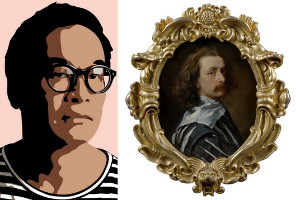
LONDON – British artist Julian Opie has made new work to display alongside the National Portrait Gallery’s self-portrait of Sir Anthony van Dyck (1599-1641), acquired in 2014 after a major public fundraising appeal, as it returns to the Gallery following a three-year nationwide tour.
In “Julian Opie after Van Dyck” (Oct. 6 – Jan. 7) one of Britain’s foremost contemporary artists has been invited to present his work in dialogue with Van Dyck’s self-portrait (c. 1640) in the 17th-century galleries. The powerful new and recent works shown in this free display include Faime. (2016), Lucia, back 3. (2017) and Beach Head, 6. (2017).
While, at first glance, Opie’s portraits are distinctly modern in their concise and abstracted forms, the style, composition and media are inspired by a variety of historic and contemporary visual sources. These range from ancient Egyptian and Roman art, and Dutch and British painted portraits of the 17th and 18th centuries, to 18th- and 19th-century Japanese prints, and the symbolic language of modern signage.
The influence of 17th-century British portraiture on the works in this display is evident in the elegant pose of several of the sitters, and the turning postures that playfully reference Van Dyck’s self-portrait. Viewing the old and new portraits side by side illuminates the influence and continuing relevance of Old Masters such as Van Dyck on British contemporary portrait practice.
“Julian Opie’s work references historical portraiture, and has often used compositional devices employed by seventeenth-century artists. The portraits in this display are a testament to Van Dyck’s lasting legacy in Britain,” said Catharine MacLeod, curator of “Julian Opie after Van Dyck” and senior curator of 17th-century portraits, National Portrait Gallery, London.
Julian Opie (b.1958) emerged as an influential figure on the British art scene in the 1980s, with a series of painted metal sculptures. Opie’s portraits are created by a process of refinement of line and form, the result of which is a distilled image that nevertheless retains key signifiers that are enough to “read” the subject’s likeness, such as the position of the head on shoulders, a facial feature or an accessory. His work has been exhibited extensively in galleries and museums worldwide.
Anthony van Dyck was born and trained in Antwerp, and went to work for the great painter Peter Paul Rubens while still in his teens. Quickly recognized as Rubens’s most talented assistant, he soon set out to gain wider experience. Van Dyck briefly visited England in 1620–1, and then spent six years traveling and painting in Italy. Work in Antwerp and the Northern Netherlands followed this, and then in 1632, he returned to England.
Here, he was named principal painter to King Charles I, knighted and housed at the king’s expense, and began producing paintings – almost all portraits. Van Dyck’s paintings, with their command of perspective and space, confident brushwork and sense of movement, set a new standard to which his contemporaries and successors aspired. Artists ranging from Gainsborough to Sargent turned to him for inspiration.
“Julian Opie after Van Dyck” will be on view Oct. 6 through Jan. 7, 2018.



